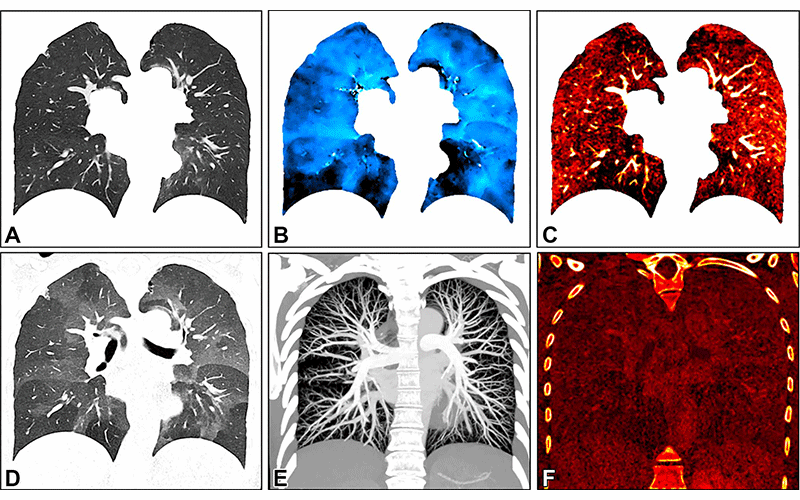According to a study published in Radiology, new CT technology enables a thorough, concurrent evaluation of lung anatomy and function, something that is not feasible with regular CT.
 Images in a 34-year-old female patient show severe smoking-associated small airway disease with patchy ground-glass opacities and mosaic pattern. The images were generated with spectral postprocessing on a coronal plane at (A) inspiration (warped for voxelwise matching with expiration), (B) ventilation, (C) perfusion, (D) expiration, (E) CT angiography, and (F) late contrast enhancement. Quantitative parameters include whole lung or lobar volume, and inspiratory (A) and expiratory (D) attenuation and functional parameters such as ventilation (B), perfusion (C), and late contrast enhancement (F). They are described using descriptive statistics or histogram analysis. Corresponding functional maps show inhomogeneous ventilation with lobular air-trapping in the lower lobes and matched perfusion inhomogeneities. CT angiography (E) and late contrast enhancement (F) images show no abnormal findings. Image Credit: https://pubs.rsna.org/doi/10.1148/radiol.230318 ©RSNA 2023
Images in a 34-year-old female patient show severe smoking-associated small airway disease with patchy ground-glass opacities and mosaic pattern. The images were generated with spectral postprocessing on a coronal plane at (A) inspiration (warped for voxelwise matching with expiration), (B) ventilation, (C) perfusion, (D) expiration, (E) CT angiography, and (F) late contrast enhancement. Quantitative parameters include whole lung or lobar volume, and inspiratory (A) and expiratory (D) attenuation and functional parameters such as ventilation (B), perfusion (C), and late contrast enhancement (F). They are described using descriptive statistics or histogram analysis. Corresponding functional maps show inhomogeneous ventilation with lobular air-trapping in the lower lobes and matched perfusion inhomogeneities. CT angiography (E) and late contrast enhancement (F) images show no abnormal findings. Image Credit: https://pubs.rsna.org/doi/10.1148/radiol.230318 ©RSNA 2023
The best imaging technique for assessing lung disease and monitoring changes over time is chest computed tomography (CT). However, specific techniques are needed for CT studies of lung function and perfusion, which cannot be combined.
Researchers in Germany and the Netherlands created an all-in-one chest imaging approach that provides information on the anatomy and function of the lungs. The procedure employs photon-counting CT technology, which provides great image quality at a lower radiation dose than a standard chest CT.
Furthermore, it offers improved spatial resolution and spectral imaging possibilities, requiring advanced software but no additional hardware.
The technique was investigated in 197 patients with clinically indicated CT for various known and unknown lung function impairments. After an intravenous contrast agent was administered, the photon-counting CT scan was performed while the patients inhaled and again when they exhaled.
The researchers had an 85% success rate in collecting all the CT-derived parameters from 166 patients.
The procedure enabled the examination of lung anatomy, ventilation, vasculature, and parenchymal perfusion all at once. Over traditional CT, the technique has shown advantages.
The improvement in the contrast-to-noise ratio and spatial resolution of the pulmonary blood volume images was substantial. In my opinion, the most important advantage is the significantly improved spectral resolution, which enables new applications such as functional imaging of the lungs with CT.
Hoen-oh Shin, M.D., Study Senior Author and Professor, Radiology, Institute of Diagnostic and Interventional Radiology, Hannover Medical School
Other Promising Applications in Lung Imaging
Other intriguing lung imaging uses for the photon-counting CT procedure exist. In patients with chronic thromboembolic pulmonary hypertension, a progressive condition caused by blood clots that do not clear from the lungs, it can provide crucial preoperative detection of areas of emphysema and perfusion abnormalities.
The postoperative regimen helped evaluate the lungs after lung or stem cell transplant procedures and permitted the evaluation of surgical success. Additionally, it can be helpful while monitoring the progression of chronic obstructive pulmonary disease and examining pathological abnormalities in lung tissue.
Dr. Shin added, “We believe that the proposed protocol is generally valuable for diseases with known or unknown lung function impairment.”
The procedure was initially used on patients with interstitial lung disease by Dr. Shin and his associates. Then, the applications were broadened to incorporate the post-COVID-19 situation, when interstitial lung disease can occasionally manifest.
Dr. Shin further stated, “With the proposed protocol, we have also been able to answer many other questions related to post-COVID-19 condition, such as the detection of acute and chronic pulmonary emboli on CT angiography, and we are currently investigating whether perfusion changes can be quantified in microvascular damage or inflammatory areas.”
The researchers are striving to streamline processing time and improve the technique’s robustness.
Dr. Shin concluded, “Regional ventilation and perfusion depend on patient position and gravity, among other factors. Further studies are needed to assess the dependence on position and depth of breathing, as well as the reproducibility of the measurements.”
Journal Reference:
Scharm, S. C., et al. (2023) Regional Pulmonary Morphology and Function: Photon-counting CT Assessment. Radiology. doi:10.1148/radiol.230318.
Source: https://www.rsna.org/